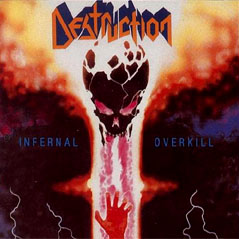Destruction - Infernal Overkill
Review: Destruction pioneered rhythmic songs that periodically expressed themselves in melodic riffs, which created a chorus-heavy foot-tapping power that launched a thousand bands, but the originators ran into trouble as the style expanded. While their melodic riffing influenced all European and most American metal to follow, the chorus-heaviness forced a split from the new death metal style and kept them stranded in a faster version of speed metal.
On their second release, Destruction reign in the chaos and add musical precision, which at the time encouraged the re-interpretation of ideas from the first EP as new songs, albeit recognizable tributes to the older work. At the same time, they mix in a greater influence from Slayer, which manifests itself in Judas Priest-tinged speeding riffs that complement the bouncier, more literal-minded chorus-pattern riffs for which this band is famous. The greater control over the ability to strum at high speed leads itself to a more complex texture of riffs, but the tendency to end phrases definitively in all parts of the song creates a monochromatic mood.
This type of music, called by "thrash metal" by some to emphasize its hybridization with thrash bands like Dirty Rotten Imbeciles (DRI) and Cryptic Slaughter in the internally-conflicted percussion that gave it an aura of descending chaos, found itself conflicted between an inclination toward eventual melodic songwriting and a reliance on its compelling rhythms. While melodic completion would have forced it into a clearer self-definition, its immersion in a disordered appearance and non-serious aesthetic kept it from the difficult implications of its praise of war, violence and evil.
Where earlier works from Destruction were sprawling and chaotic demonstrations of emotion, the evolution of the band converges on heavy metal song structures with faster riffs and the dominating rhythms that emerged from earlier works. The result satisfies those who like the power metal style of pat rhythms and epic solos, wailing vocals and easily identifiable parts of each song, but it precluded the ability to expand song structure like the death metal oncogenesis compounding around them.

